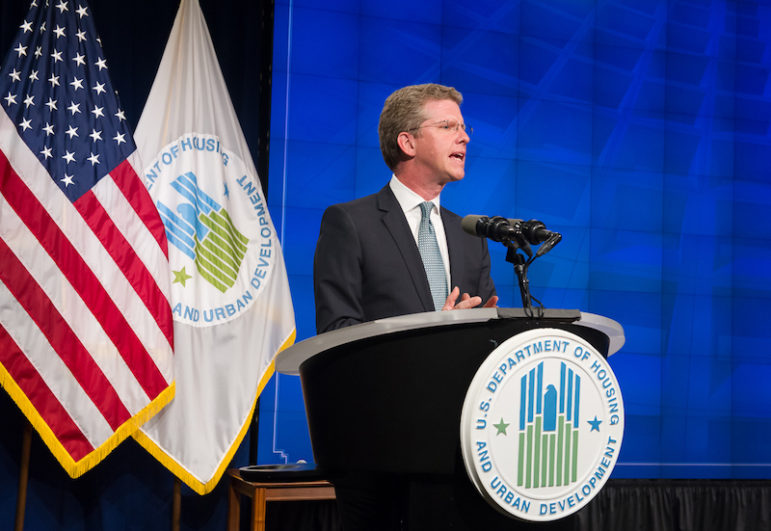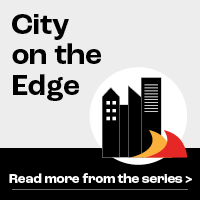The unusually detailed policy document calls for zero-emissions buildings, pooled philanthropic funding for parks and more attention to the historic injustices embedded in environmental risks.

HUD
Shaun Donovan delivers his farewell remarks as HUD secretary in 2014. He had a role in the federal government’s response to Superstorm Sandy, an event that made clear the degree of risk climate change poses to New York City.A Democratic mayoral candidate has put climate change at the center of his run for City Hall, issuing a lengthy policy outline that critiques the de Blasio administration even as it doubles down on some of its environmental policies.
Shaun Donovan, a former city housing commissioner who served as the secretary of Housing and Urban Development and budget director in the Obama administration, last week released a 6,000-word climate policy called “A More Sustainable, Equitable, and Just New York.”
Calling Donovan “a visionary who understands the climate emergency, but will also act,” the plan says the candidate “will match urgency with a deep focus on implementation and competent management to follow through on ambitious emissions goals and policies.”
The plan is more detailed than what candidates typically issue. Given the scale and seriousness of the climate problem, it is perhaps little surprise that even as it stakes out new territory, it leaves some questions unanswered.
Justice a priority
“Building upon the legacy of former Mayor Michael Bloomberg, New York City will return to the global stage in 2022 as a leading example of how to mitigate, adapt to and prepare for climate change,” the document reads.
That’s a reference to Bloomberg’s PlaNYC, which first charted a greener path for the city. Issued in 2006, PlaNYC was a landmark in mainstream policy discussion about reacting to the threat of climate change. Bill de Blasio said little about the environment as he ran to succeed Bloomberg, but his administration—sometimes prodded by the City Council—has advanced ambitious environmental policies, as Donovan’s policy paper quietly acknowledges.
Like de Blasio’s OneNYC 2050 plan, Donovan’s vision weds environmental policy to broader efforts to address historical inequities. The plan’s primary focus is on environmental justice.
“For too long, underserved communities have dealt with disproportionate levels of pollution, poor housing quality, and a lack of access to clean air and clean water, leading to adverse health effects–and they’ve been further devastated by COVID-19,” it reads. “Shaun will prioritize these communities in both preparing for the impacts of climate change, and in the solutions to catalyzing the clean energy revolution in New York City.”
Eddie Bautista, the executive director of the New York City Environmental Justice Alliance (NYC-EJA), called the plan “a thoughtful, visionary platform that centers and attempts to correct historic racial and related disparities in transformational and forward-looking ways.”
“It also reflects many of NYC-EJA’s and the broader environmental/climate justice movement’s priorities,” Bautista added, noting that Donovan has reached out to members of the alliance, some of whom know him from his work with HUD on the effort to rebuild from Sandy.
Cutting emissions—more
Donovan vows to issue an Environmental Justice Executive Order within his first 100 days in office, and develop “climate equity checklists and scorecards” for city agencies, as well as employ a social vulnerability index to determine which communities are most vulnerable, not just by virtue of their physical location but also their exposure to economic and social injustice.
Buildings are the city’s biggest contributor to greenhouse gas emissions, and the de Blasio administration has already set up an aggressive system for reducing them in 2019’s Local Law 97, championed by Council environmental chair Costa Constantinides, which Donovan’s plan calls a “landmark” and “one of the most ambitious local policies to cut greenhouse gas emissions globally.” Donovan says he wants to refine that plan and and help property owners comply with it by fully implementing a program the city has already launched called PACE that allows people to pay for new, cleaner heating technology by borrowing against expected savings on future heating bills.*
He also wants “to enact a zero-carbon building code for new buildings by 2030 and eliminate fossil fuels from new building construction and operation even sooner.” Noting that New York sees some 50,000 buildings built or renovated each year, the Donovan plan notes: “Without more stringent codes, emissions from new buildings will be ‘locked in’ for decades.”
The plan comes out in support of locating renewable energy, new wastewater treatment facilities and possibly composting infrastructure on a revamped Rikers Island. Donovan vows to join efforts to close dirty “peaker plants” that are used when electricity demand is high, and often pollute into historically-maligned neighborhoods.
Donovan’s plan also describes a new NYC Climate Corps—sort of an AmeriCorps for green jobs. He pledges to expand bike, bus and electric vehicle infrastructure, make some Open Streets permanent, and to incorporate climate curriculum into K-12 schooling. He wants to resume the city’s development of an organics recycling program (de Blasio stalled it recently in light of budget pressures) and create a program for recycling construction waste.
Dealing with the impacts
No matter how aggressive the city is at setting goals for reducing greenhouse gas emissions, or how successful it is at meeting them, New York is going to have to deal with the impact of climate change.
The most dramatic of those impacts is likely to be rising sea levels and the growing frequency and intensity of coastal storms. Elected a year after Superstorm Sandy illustrated the gravity of those risks, de Blasio has been faulted for not moving quickly or comprehensively enough to mitigate them.
It is not clear that Donovan would move much faster. His vision calls for developing “a dynamic, comprehensive five borough resilience plan that considers cross-boundary impacts across the region, responds to real-time data and climate science, and is rooted in community-driven engagement.”
One local resilience expert, who asked not to be named so his nonprofit employer would not be seen as taking sides in the mayoral race, noted that there are already well-developed plans for some parts of the city’s waterfront, like Resilient Edgemere, a comprehensive plan for that Queens neighborhood that was issued in 2017 but needs to be funded and implemented. Many of the plans for protecting lower Manhattan still need to be pushed through to completion. There have also been planning studies of 11 Resilient Neighborhoods across the city, only some of which have led to concrete changes. With the clock ticking, the expert said, mayoral candidates should probably talk about how they plan to get existing plans built, in addition to launching new planning processes.
In writing that he wants to “rethink traditionally-used cost-benefit analysis to prioritize investment in historically disadvantaged communities and those most at risk from climate change,” the Donovan plan does not directly address the question of whether some New York City communities might be unlivable once sea level rise occurs—or when and how the city should start helping families and businesses relocate.
Donovan does seem willing to talk about that topic, when asked. A spokesperson tells City Limits that as mayor, Donovan “will consider strategic retreat or resettlement from high-risk areas as a viable option alongside other adaptation and resilience strategies, as long as the city uses robust climate science and social vulnerability data to properly assess risk, leverages state and federal funds to put proper incentives in place, and provides adequate support to households and communities to help them make informed decisions about their homes.”
Acknowledging the fact that extreme heat is just as much of a climate risk to New York City as rising seawaters, Donovan vows to subsidize air conditioners for “environmental justice communities” and “establish an air conditioner rebate program that allows people to trade-in old air conditioners for new, efficient models.” He also calls for expanding de Blasio’s CoolRoofs program, which uses light-colored and reflective paint to reduce buildings’ absorption of heat.
Increasing the amount of green space is another priority. Donovan notes the very small share of the city budget that goes to the Parks Department.
“This is unacceptable, and we plan to make NYC Parks an essential service in order to safeguard a minimum level of public funding,” the plan reads, although it does not specify how large a Parks budget Donovan supports. Instead, it talks about “restructuring funding to ensure equitable quality, maintenance, and access” and “prioritizing funding for neighborhoods and spaces that have less open space.”
Donovan’s plan calls for more public-private partnerships in public spaces. It also advocates “decentralizing private funding pools by distributing funds raised through parks conservancies and foundations (with funds specifically targeting neglected parks and spaces)–while prioritizing environmental justice communities first.”
That sounds like a revisit of a controversial idea de Blasio pitched early in his mayoralty the would prevent conservancies from raising and spending money only on their favored parks, neglecting parks without high-wealth constituencies. Asked if Donovan was going there, his spokeswoman tells City Limits: “Parks and public spaces must be maintained and funded regardless of where in the city they are located. A Donovan Administration will commit to doing a thorough review of funding streams in order to determine equitable allocation of funds across the city, in close coordination with stakeholders.”
*Correction: The original version of the story erroneously indicated that Donovan wanted to create this program. In fact, the city is already developing it.









